
Thailand's Royal Barge Procession
Encyclopedia

Thailand
Thailand , officially the Kingdom of Thailand , formerly known as Siam , is a country located at the centre of the Indochina peninsula and Southeast Asia. It is bordered to the north by Burma and Laos, to the east by Laos and Cambodia, to the south by the Gulf of Thailand and Malaysia, and to the...
Royal Barge Procession ' onMouseout='HidePop("74371")' href="/topics/Royal_Thai_General_System_of_Transcription">RTGS:
Royal Thai General System of Transcription
The Royal Thai General System of Transcription is the official system for rendering Thai language words in the Latin alphabet, published by the Royal Institute of Thailand...
Krabuan Phayuhayattra Chonlamak) is a ceremony of both religious and royal
Monarchy
A monarchy is a form of government in which the office of head of state is usually held until death or abdication and is often hereditary and includes a royal house. In some cases, the monarch is elected...
significance which has been taking place for nearly 700 years. The exquisitely crafted Royal Barges are a blend of craftsmanship and traditional Thai art
Thai art
Traditional Thai art is primarily composed of Buddhist art. Traditional Thai sculpture almost exclusively depicts images of the Buddha. Traditional Thai paintings usually consist of book illustrations, and painted ornamentation of buildings such as palaces and temples.-Painting:Traditional Thai...
. The Royal Barge Procession takes place rarely, typically coinciding with only the most significant cultural and religious events. During the reign of King Bhumibol Adulyadej, spanning over 60 years, the Procession has only occurred 16 times.
The Royal Barge Procession, in the present, consists of 52 barges: 51 historical Barges, and the Royal Barge, the Narai Song Suban, which King Rama IX built in 1994. It is the only Barge built during King Bhumibol's reign. These barges are manned by 2,082 oarsmen. The Procession proceeds down the Chao Phraya River
Chao Phraya River
The Chao Phraya is a major river in Thailand, with its low alluvial plain forming the centre of the country. It runs through Bangkok, the capital city, and then empties into the Gulf of Thailand.-Etymology:...
, from the Wasukri Royal Landing Place in Khet Dusit
Dusit
Dusit is one of the 50 districts of Bangkok, Thailand.The district forms the main administrative center of Thailand, as both the national parliament as well as the royal palace are located in this district, as well as several ministries...
, Bangkok
Bangkok
Bangkok is the capital and largest urban area city in Thailand. It is known in Thai as Krung Thep Maha Nakhon or simply Krung Thep , meaning "city of angels." The full name of Bangkok is Krung Thep Mahanakhon Amon Rattanakosin Mahintharayutthaya Mahadilok Phop Noppharat Ratchathani Burirom...
, passes the Temple of the Emerald Buddha
Emerald Buddha
The Emerald Buddha is the palladium of the Kingdom of Thailand, a figurine of the sitting Buddha, made of green jadeite , clothed in gold, and about 45 cm tall...
, the Grand Palace, Wat Po , and finally arrives at Wat Arun
Wat Arun
Wat Arun Rajwararam is a Buddhist temple in the Bangkok Yai district of Bangkok, Thailand, on the Thonburi west bank of the Chao Phraya River. The full name of the temple is Wat Arunratchawararam Ratchaworamahawihan...
.
History
Thailand's Royal Barge Procession most likely began during the AyutthayaAyutthaya kingdom
Ayutthaya was a Siamese kingdom that existed from 1350 to 1767. Ayutthaya was friendly towards foreign traders, including the Chinese, Vietnamese , Indians, Japanese and Persians, and later the Portuguese, Spanish, Dutch and French, permitting them to set up villages outside the walls of the...
period in the 14th century. Western visitors witnessed and wrote about the "immense procession with 200 boats" upon their arrival in Thailand in the 18th century. During the processions, the oarsmen were kept in rhythm by the beating of drum
Drum
The drum is a member of the percussion group of musical instruments, which is technically classified as the membranophones. Drums consist of at least one membrane, called a drumhead or drum skin, that is stretched over a shell and struck, either directly with the player's hands, or with a...
s, with accompanying music. This traditional boat song was written by Prince Dhamma Dibes of the late Ayutthaya period.
In 1767, Burma invaded Thailand, and amid the destruction, hundreds of the barges were burned and destroyed. General Taksin
Taksin
Taksin ; was the only King of the Thonburi Kingdom...
rallied the Thais
Thai people
The Thai people, or Siamese, are the main ethnic group of Thailand and are part of the larger Tai ethnolinguistic peoples found in Thailand and adjacent countries in Southeast Asia as well as southern China. Their language is the Thai language, which is classified as part of the Kradai family of...
and established the new capital at Thonburi
Thonburi
Thon Buri is an area of modern Bangkok. It was capital of Thailand from 1767 to 1782, during the reign of King Taksin, after the previous capital Ayutthaya was sacked by the Burmese. It is located on the opposite bank of Chao Phraya River to Bangkok...
. During his short 15 year reign, Taksin ordered the reconstruction of the barge fleet, and used a fleet of 115 barges to carry the holy image of Buddha
Gautama Buddha
Siddhārtha Gautama was a spiritual teacher from the Indian subcontinent, on whose teachings Buddhism was founded. In most Buddhist traditions, he is regarded as the Supreme Buddha Siddhārtha Gautama (Sanskrit: सिद्धार्थ गौतम; Pali: Siddhattha Gotama) was a spiritual teacher from the Indian...
to the new capital.
General Chakri succeeded General Taksin on the latter's death, and moved the capital to present-day Bangkok, across the Chao Phraya River from Thonburi. General Chakri, the first king of the Chakri Dynasty, named King Buddha Yodfah, or Rama I, began the Royal Kathin Ceremony Procession. The Kathin Ceremony
Kathina
Kathina is a Buddhist festival which comes at the end of Vassa, the three-month rainy season retreat for Theravada Buddhists. The season during which a monastery may hold a Kathina festival is one month long, beginning after the full moon of the eleventh month in the Lunar calendar .It is a time...
is the presentation of Kathin robes and the earning of merit in tribute to and support of the Buddhist Monks.
Soon after his accession to the throne in 1782, King Rama I ordered the construction of the Royal Barge Si Suphannahong. The Royal Barge Si Suphannahong was the principle Royal Barge for over 100 years. Rama VI, in 1911, launched its successor, also named Suphannahong.
Prince Nakhon Sawan, during the reign of Rama V, regulated the formations, which became established as the standard "Major" and "Minor" formations still used today.
The Processions took place occasionally, until 1932, the dissolution of the absolute monarchy, and were not resumed until 1957, in celebration of the 25th century of the Buddhist Era. In 1959, Bhumibol Adulyadej revived the Royal Barge Procession for the Royal Kathin.
Occurrences
In the reign of the present king, Bhumibol Adulyadej, 16 royal barge processions have been conducted:Major Sailings

- The 25th Century Celebrations of the Buddhist Era - 14 May 1957
- Royal Barge Procession in the Bangkok Bicentennial Celebrations, 5 April 1982
- Royal Barge Procession for Royal Kathin Ceremony at Wat Arun, 20 October 1982
- Royal Barge Procession for Royal Kathin Ceremony at Wat Arun, 16 October 1987 (King's 60th Birthday)
- Royal Barge Procession for Royal Kathin Ceremony at Wat Arun, 7 November 1996 (King's 50th anniversary on the throne)
- Royal Barge Procession for Royal Kathin Ceremony at Wat Arun, 4 November 1999 (King's 6th cycle, 72 years old)
- Royal Barge Procession for APEC Meeting 20 October 2003 (video)
- King's 60th – Diamond Jubilee of the king's accession to the throne. 12 June 2006 (52 barges) (video)
- Royal Barge Procession for Royal Kathin Ceremony at Wat Arun, 5 November 2007 (King's 80th Birthday) (video)
- Royal Barge Procession for Royal Kathin Ceremony at Wat Arun, 22 October 2011 (King's 7th cycle, 84 years old) *Postponed due to current flooding phenomenon, new date is 5 December 2011 on the King's Birthday)
Additional sailings (Royal Kathin)
- Royal Barge Procession for Royal Kathin Ceremony at Wat Arun 15 November 1959
- Royal Barge Procession for Royal Kathin Ceremony at Wat Arun, 2 November 1961
- Royal Barge Procession for Royal Kathin Ceremony at Wat Arun, 22 October 1962
- Royal Barge Procession for Royal Kathin Ceremony at Wat Arun, 15 November 1964
- Royal Barge Procession for Royal Kathin Ceremony at Wat Arun, 19 October 1965
- Royal Barge Procession for Royal Kathin Ceremony at Wat Arun, 27 October 1967
- Barge Procession to transport the Buddha Image, 12 April 1982
Organization
The Royal Barge Procession is conducted in one of two formations, the Major and the Minor. The Major formation, also known as the Major Battle Formation (Petch Phuang Major Battle Formation) dates from the time of King Narai. This formation is used for the more significant events, such as The Royal Kathin Ceremony, the movement of the sacred image of Buddha, or important occasions of state. The Petch Phuang Formation is arranged into five columns, with the Royal Barges in the center, and two rows of war barges on each side. In the Minor formation, there are three columns, the Royal Barges in the middle, and a single row on each side.Major Barge Procession
Arranged in five rows.- 1 pair of lead barges carrying high ranking officials with the position of permanent undersecretary.
- 1 pair of ancient Thai battle boats with cannons at the bow, carrying army conniellers.
- 2 pairs of plain outer barges
- 4 pairs of inner barges with decorated mastheads in the shape of the garuda, monkeys, and ogres.
- 1 outer drum boat, 1 inner drum boat, with six musicians playing the Java pipes and Indian drums.
- 1 inner, 1 outer boat for the Royal Police.
- The Ekachai Barge with covered throne for monks' robes, the Buddha image or flower arrangements complete with regalia.
- The Ekachai Hern Hao Barge and the Ekachai Lao Thong Barge, carrying musicians to lead the Royal Barge.
- The Royal Barge with covered throne and regalia
- Pavilion Barge for the king's change of robes
- Second Royal barge
- 1 pair of Police barges
- 2 pairs of Army barges
- 1 pair of plain rear barges
Minor Barge Procession
- 1 pair lead barges
- 1 pair attack barges
- 7 pairs plain barges
- 4 pairs animal masthead barges
- 1 left drum boat, 1 right drum boat
- 2 police boats—left and right
- The Ekachai Barge with covered throne for monks' robes, Buddha image or flower arrangement complete with regalia
- The Ekachai Hern Hao Barge with musicians and the Ekachai Lao Thong Barge
- The Royal Barge with appropriate regalia
- The Second Royal barge
- 1 pair police Barges
The Royal Barges
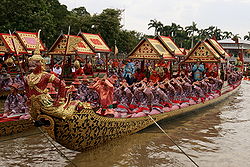
Lacquer
In a general sense, lacquer is a somewhat imprecise term for a clear or coloured varnish that dries by solvent evaporation and often a curing process as well that produces a hard, durable finish, in any sheen level from ultra matte to high gloss and that can be further polished as required...
and glass jewels, with a crystalline ball and tassle dangling from her mouth. This 46-meter craft was carved from a single trunk of teak
Teak
Teak is the common name for the tropical hardwood tree species Tectona grandis and its wood products. Tectona grandis is native to south and southeast Asia, mainly India, Indonesia, Malaysia, and Burma, but is naturalized and cultivated in many countries, including those in Africa and the...
wood, and was launched 13 November 1911. There is a golden pavilion
Pavilion (structure)
In architecture a pavilion has two main meanings.-Free-standing structure:Pavilion may refer to a free-standing structure sited a short distance from a main residence, whose architecture makes it an object of pleasure. Large or small, there is usually a connection with relaxation and pleasure in...
on board to house the king and his royal family.
The World Ship Trust, in 1992, named the Royal Barge Suphannahong a Maritime World Heritage.
The original The Royal Barge Anantanakkharat ("Ananta
Shesha
In Hindu tradition, Shesha or Sheshanaag is the king of all nagas, one of the primal beings of creation, and according to the Bhagavata Purana, an Avatar of the Supreme God known as Sankarshan. In the Puranas, Shesha is said to hold all the planets of the Universe on his hoods and to constantly...
, the King of Serpents") was built during the reign of Rama III (King Nangklao). It was used as the primary Royal Barge of Rama IV (King Mongkut). The current Anantanakkharat was built during the Reign of Rama VI (King Vajiravudh), and launched on 14 April 1914. The bow is carved into the 7-headed Nakkharat, the mystical snake-like creature, in gold lacquer and glass jewels.
The Royal Barge Anekkachatphuchong ("the Variety of Serpents") is the oldest of the four Royal Barges, being the actual barge built during the reign of Rama V (King Chulalongkorn). While no mythical figure is readily visible on the bow, numerous small ornamental Naga figures are carved into the bow.
The Royal Barge Narai Song Suban Ratchakan Thi Kao or The Royal Barge Narai Song Suban HM King Rama IX ("God Narayana
Vishnu
Vishnu is the Supreme god in the Vaishnavite tradition of Hinduism. Smarta followers of Adi Shankara, among others, venerate Vishnu as one of the five primary forms of God....
on his carrier, Garuda
Garuda
The Garuda is a large mythical bird or bird-like creature that appears in both Hindu and Buddhist mythology.From an Indian perspective, Garuda is the Hindu name for the constellation Aquila and...
") is the only barge built during the reign of Bhumipol Adulyadej, who laid the keel in 1994. It was built under commission by the Royal Thai Navy
Royal Thai Navy
The Royal Thai Navy is the navy of Thailand and part of the Royal Thai Armed Forces, it was established in the late 19th century. Admiral Prince Abhakara Kiartiwongse is "The Father of Royal Thai Navy". Similar to the organizational structure of the United States, the Royal Thai Navy includes the...
and the Thai Department of Fine Arts and was launched 6 May 1996 to coincide with the celebration of the fiftieth anniversary of Bhumibol Adulyadej's accession to the throne.
The names of the four Royal Barges are composed in a consistent rhyme: "Suphannahong", "Narai Song Suban", "Anantanakkharat" and "Anekkachatphuchong".
| Suphannahong | Anantanakkharat | Anekkachatphuchong | Narai Song Suban HM Rama IX | |
|---|---|---|---|---|
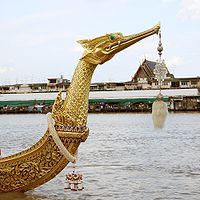 |
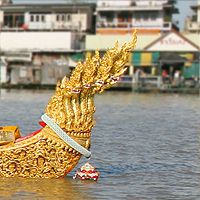 |
 |
 |
|
 |
 |
 |
 |
|
| Length: | 46.15 m | 44.85 m | 45.67 m | 44.30 m |
| Width at Beam: | 3.17 m | 2.58 m | 2.91 m | 3.20 m |
| Hull Depth: | 94 cm | 87 cm | 91 cm | 1.10 cm |
| Draught: | 41 cm | 31 cm | 1.46 m | |
| Displacement: | 15 tons | 15.26 tons | 7.7 tons | 20 tons |
| Crew: | 50 oarsmen 2 steersmen 1 chanter 2 officers fore 2 officers aft 1 signalman 1 standard bearer 7 bearers of the Royal Insignia |
54 oarsmen 2 steersmen 1 chanter 1 signalman 1 standard bearer 7 bearers of the Royal Insignia |
61 oarsmen 2 steersmen 1 chanter 1 signalman 1 standard bearer 2 officers (one fore, one aft) 7 bearers of the Royal Insignia |
50 oarsmen 2 steersmen |
Escort barges
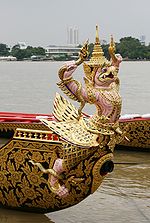
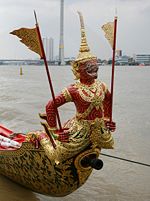
Ekachai Class Barges are the two barges with a gold painting of a horned creature that is half-nāga
Naga
Naga or NAGA may refer to:* Nāga, a group of serpent deities in Hindu and Buddhist mythology.-People:* Nayan / Nayar/Nair people of Kerala Society* Naga people, a diverse ethnic identity in Northeast India...
half-dragon
Dragon
A dragon is a legendary creature, typically with serpentine or reptilian traits, that feature in the myths of many cultures. There are two distinct cultural traditions of dragons: the European dragon, derived from European folk traditions and ultimately related to Greek and Middle Eastern...
, Ekachai Hern How and Ekachai Lao Thong. They might be used to tow Suphannahongse in case of a strong current. Unlike other escort barges, Ekachai class barges are not equipped with cannon
Cannon
A cannon is any piece of artillery that uses gunpowder or other usually explosive-based propellents to launch a projectile. Cannon vary in caliber, range, mobility, rate of fire, angle of fire, and firepower; different forms of cannon combine and balance these attributes in varying degrees,...
. The two barges can be distinguished by the slightly different pattern.
Krut Class Barges are the two barges with garuda
Garuda
The Garuda is a large mythical bird or bird-like creature that appears in both Hindu and Buddhist mythology.From an Indian perspective, Garuda is the Hindu name for the constellation Aquila and...
figureheads with nagas caught on their wings and feet. The garuda on Krut Hern Het is red while the one on Krut Tret Traichak is pink.
Krabi Class Barges consist of four barges with Vanara
Vanara
Vānara popularly refers to a group of ape-like humanoids in the Hindu epic Ramayana who were brave and inquisitive by nature. They possessed supernatural powers and could change their shapes...
figureheads, Pali Rang Thawip, Sukrip Khrong Mueang, Krabi Ran Ron Rap, and Krabi Prap Mueang Man. The bow of Pali Rang Thawip depicts Vali
Vali (Ramayana)
In the Hindu epic Ramayana, the vanara Vali , also known as Bali , , , Yuan: Bari, , Lao: Palichan) was king of Kishkindha, a son of Indra and the elder brother of Sugriva...
, the elder brother of Sugriva
Sugriva
In the Hindu epic Ramayana, Sugriva , also spelled Sugreeva or Sugreev, was the younger brother of Bali, whom he succeeded as ruler of the vanara or monkey kingdom Kishkindha. Ruma was his wife. He was the son of Surya, the Hindu deity of the sun...
on Sukrip Khrong Mueang, rulers of the Kishkindha
Kishkindha
Kishkindha is mythical the monkey kingdom of the Vanara King Sugriva, the younger brother of Vali, in the Indian mythology of Ramayana times...
Kingdom. Both have crowns on their heads with the body color green and red respectively. Krabi Ran Ron Rap and Krabi Prap Mueang Man feature uncrowned warriors of Vanara Nilaphat (black body) and Hanuman
Hanuman
Hanuman , is a Hindu deity, who is an ardent devotee of Rama, a central character in the Indian epic Ramayana and one of the dearest devotees of lord Rama. A general among the vanaras, an ape-like race of forest-dwellers, Hanuman is an incarnation of the divine and a disciple of Lord Rama in the...
(white body), respectively.
Asura Class Barges consists of two barges with half-bird, half-ogre figureheads. The bow on Asura Vayuphak has an indigo body in a purple coat, while Asura Paksi has a green body in a purple (front) and green (back) coat.
Suea Class Barges are the barges with the painting of a tiger, Suea Thayan Chon and Suea Kamron Sin. The names of the barges are clearly written on the bow.
Lesser escort barges
The largest number of barges in the fleet is the Lesser Escorts and Attendants such as Ruea Dang, Ruea Saeng, Police barges and Drum barges. They have no figurehead and no cannon.Preservation
The current fleet of barges was restored during the reign of King Bhumibol Adulyadej. They were damaged during the World War II bombing. The dock that stored the barges, located in the Bangkok NoiBangkok Noi
Bangkok Noi is one of the 50 districts of Bangkok, Thailand. Neighboring districts are Bang Phlat, Phra Nakhon , Bangkok Yai, Phasi Charoen, and Taling Chan.-History:...
district, was then turned into the National Museum of Royal Barge. Only eight important barges, including all four Royal Barges, are displayed in the museum due to space constraint. The remaining are kept in the dock next to Wasukri Pier. All are stored out of water to avoid deterioration. Only for a Royal Barge Procession are the barges returned to the water for rehearsals and the actual sailing.
See also
- Monarchy of Thailand
- 60th Anniversary Celebrations of Bhumibol Adulyadej's Accession
External links
- Royal Kathin Ceremony
- Royal Barge Procession Photos (Java-enhanced photos of the APEC 2003 Royal Barge Procession).
- Royal Barge Procession Video ( Dress rehearsal for the Royal Barge Procession on the JAO PHRAYA river, Bangkok, Thailand, 7 October 1999).

